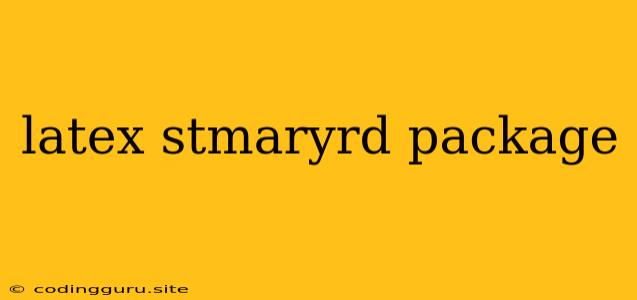The Stmaryrd Package: Enhancing Your LaTeX Diagrams
The world of LaTeX is rich with packages designed to expand its capabilities. One particularly useful package for visual representation is the Stmaryrd package. It specializes in providing a vast range of symbols, particularly those found in mathematical and logical contexts. This article aims to delve into the Stmaryrd package, exploring its features, explaining its usage, and highlighting its advantages in crafting professional-looking LaTeX documents.
Why Use the Stmaryrd Package?
You might wonder, "Why bother with an extra package when LaTeX already has a robust symbol set?" The answer lies in the Stmaryrd package's specialization in symbols often used in areas like:
- Logic and Set Theory: Symbols like "¬" (negation), "∧" (conjunction), "∨" (disjunction), "⇒" (implication), "⇔" (equivalence), "∀" (universal quantifier), "∃" (existential quantifier), and many more.
- Formal Languages and Automata Theory: Symbols for "empty string" (ε), "Kleene star" (*), "union" (∪), "intersection" (∩), and others.
- Graph Theory: Symbols for representing edges, vertices, and other graphical elements.
- Computer Science and Programming: Symbols like "∈" (element of), "∉" (not an element of), "⊆" (subset), "⊂" (proper subset), and others.
Implementing the Stmaryrd Package
Using the Stmaryrd package is simple. You simply need to include the following line in the preamble of your LaTeX document:
\usepackage{stmaryrd}
Once this line is included, you can access all the symbols offered by the package.
Key Symbols Provided by the Stmaryrd Package
The Stmaryrd package offers a wide range of symbols. Here are some of the most commonly used ones:
-
Logical Symbols:
\neg: ¬ (negation)\land: ∧ (conjunction)\lor: ∨ (disjunction)\Rightarrow: ⇒ (implication)\Leftrightarrow: ⇔ (equivalence)\forall: ∀ (universal quantifier)\exists: ∃ (existential quantifier)\bot: ⊥ (bottom, falsehood)\top: ⊤ (top, truth)
-
Set Theory Symbols:
\emptyset: ∅ (empty set)\subsetneq: ⊂ (proper subset)\subseteq: ⊆ (subset)\supsetneq: ⊃ (proper superset)\supseteq: ⊇ (superset)\in: ∈ (element of)\notin: ∉ (not an element of)\cup: ∪ (union)\cap: ∩ (intersection)\setminus: \ (set difference)\times: × (Cartesian product)
-
Formal Languages and Automata Theory:
\epsilon: ε (empty string)\ast: * (Kleene star)\oplus: ⊕ (symmetric difference)
-
Graph Theory and Other Symbols:
\llbracket: llbracket (left double bracket)\rrbracket: rrbracket (right double bracket)\leftllbracket: llbracket (left double bracket, adjustable size)\rightrrbracket: rrbracket (right double bracket, adjustable size)\lceil: ⌈ (left ceiling)\rceil: ⌉ (right ceiling)\lfloor: ⌊ (left floor)\rfloor: ⌋ (right floor)\langle: ⟨ (left angle bracket)\rangle: ⟩ (right angle bracket)\left\langle: ⟨ (left angle bracket, adjustable size)\right\rangle: ⟩ (right angle bracket, adjustable size)\vert: | (vertical bar)
Example Usage
Here's an example showcasing the Stmaryrd package in action:
\documentclass{article}
\usepackage{amsmath}
\usepackage{stmaryrd}
\begin{document}
Let $A = \{1, 2, 3\}$ and $B = \{2, 3, 4\}$. Then:
* The union of $A$ and $B$ is $A \cup B = \{1, 2, 3, 4\}$.
* The intersection of $A$ and $B$ is $A \cap B = \{2, 3\}$.
* The difference of $A$ and $B$ is $A \setminus B = \{1\}$.
The implication $p \Rightarrow q$ is true unless $p$ is true and $q$ is false.
\end{document}
This code will produce a nicely formatted document with clear mathematical expressions using symbols provided by the Stmaryrd package.
Advantages of the Stmaryrd Package
- Comprehensive Symbol Set: The Stmaryrd package offers a wide range of symbols, covering many mathematical and logical needs.
- Professional Appearance: The symbols provided by Stmaryrd are designed to look professional and consistent with standard LaTeX formatting.
- Ease of Use: Including the package is straightforward, and the symbols are easily accessible through simple commands.
Conclusion
The Stmaryrd package is a valuable tool for anyone working with LaTeX who needs a comprehensive set of symbols, particularly for mathematical and logical expressions. Its ease of use and professional output make it an excellent choice for creating visually appealing and accurate documents. By including the Stmaryrd package in your LaTeX workflow, you can significantly enhance the clarity and professionalism of your documents.
